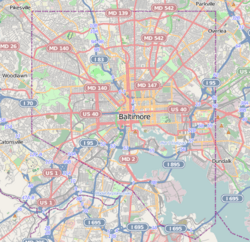Peale Museum facts for kids
|
The Peale
|
|

Museum building in 2013
|
|
| Location | 225 North Holliday Street, Baltimore, Maryland |
|---|---|
| Built | 1814 |
| Architect | Robert Carey Long, Sr. |
| Architectural style | Georgian |
| NRHP reference No. | 66000915 |
Quick facts for kids Significant dates |
|
| Added to NRHP | October 15, 1966 |
| Designated NHL | December 21, 1965 |
The Peale is a special community museum in Baltimore, Maryland. It opened in 2022 after being updated for five years. This building is super important because it was the very first one in the Western Hemisphere made just to be a museum!
The first museum here, started by Rembrandt Peale, was open from 1814 to 1829. Later, the building became Baltimore's City Hall. From 1878 to 1887, it was a groundbreaking school. It was one of the first grammar schools and the very first high school for African American students in Baltimore.
The building got a big makeover in 1931 and became the Municipal Museum of Baltimore. It was updated again in 1978 and reopened in 1981 as the Peale Museum. The Municipal Museum closed in 1997. Its collection moved to the Maryland Historical Society.
Contents
The Peale's Amazing History
Rembrandt Peale's First Museum
In 1814, a talented artist named Rembrandt Peale opened his museum. It was called "Peale's Baltimore Museum and Gallery of Fine Arts." You can find it at 225 North Holliday Street in Baltimore.
Rembrandt was the son of Charles Willson Peale, another famous artist. Charles also started a museum in Philadelphia. The Baltimore museum building was special. It was the first building in the Western Hemisphere built just for a museum. Robert Cary Long, Sr. designed it.
Rembrandt Peale's museum showed paintings of famous Americans. Some of these were painted by Rembrandt himself. It also had a huge skeleton of a prehistoric mastodon. Charles Willson Peale found this mastodon in 1801.
During the Battle of Baltimore in 1814, something interesting happened. Rembrandt Peale and his family stayed in the museum. They hoped the British army would think it was their home and leave it alone.
The museum was so famous that people often just called it the "Baltimore Museum." Rembrandt's brother, Rubens Peale, helped run the museum until 1829.
The museum was also the first building in Baltimore to have gas lighting. Imagine how exciting that must have been!
Changes and New Uses
In 1829, the museum building was sold because of money problems. The exhibits moved to a new building. This new place became the Baltimore Museum and Gallery of Fine Arts in 1834.
The original museum building then had many different jobs. From 1830 to 1875, it served as the first Baltimore City Hall. This means it was where the city's government worked.
Later, the building became a school. In 1878, it opened as the Male and Female Colored School No. 1. This was a very important school. It was one of the first grammar schools and the first high school for African American students in Baltimore. The high school started in 1883. It was the beginning of what is now Frederick Douglass High School. The school stayed open until 1887.
After the school, the building housed the Bureau of Water Supply. This was from 1887 to 1916. Then, from 1916 to 1928, different shops and factories rented the space.
The Peale as a Modern Museum
By 1928, the building was in bad shape. It was almost torn down! But it was saved and renovated. In 1931, it reopened as the Municipal Museum of Baltimore. John Henry Scarff, an architect from Baltimore, oversaw this renovation.
In 1965, the building was recognized as a National Historic Landmark. This means it's a very important historical place.
The building had another big renovation from 1978 to 1981. It reopened as the Peale Museum. In 1985, it became part of a group of historic sites called the Baltimore City Life Museums.
However, this group closed in 1997. The Peale Museum's collection moved to the Maryland Historical Society. The original building on North Holliday Street was empty for a while. It started hosting public events again in 2017.
In 2014, people started a campaign to raise money to restore the museum. The restoration project finished in 2022. In August 2022, "the Peale," Baltimore's Community Museum, officially opened its doors again!
See also
- Peale's Barber Farm Mastodon Exhumation Site




